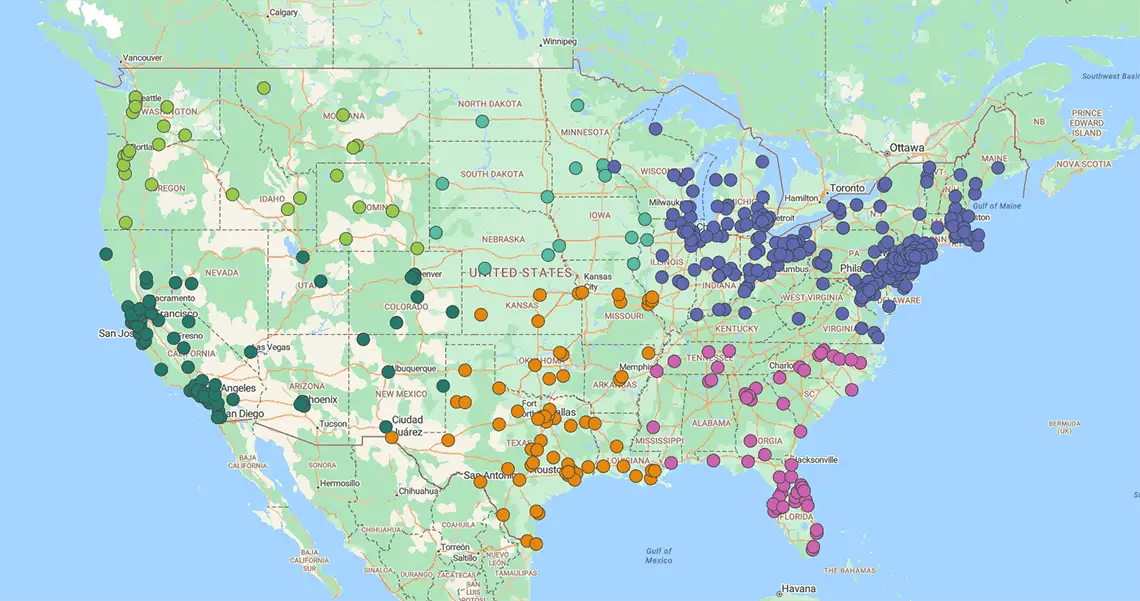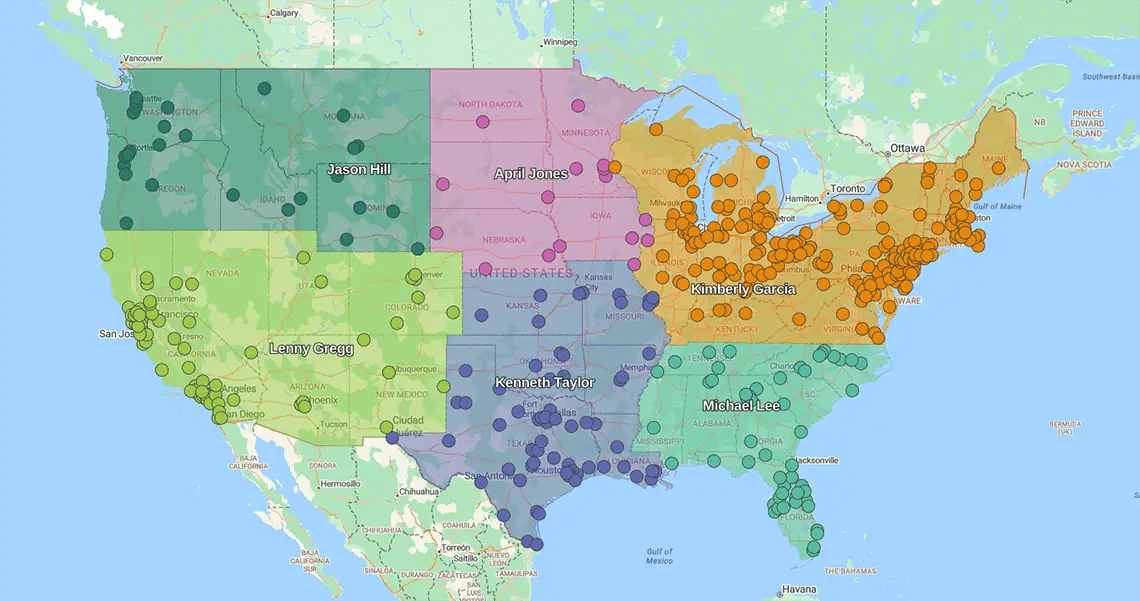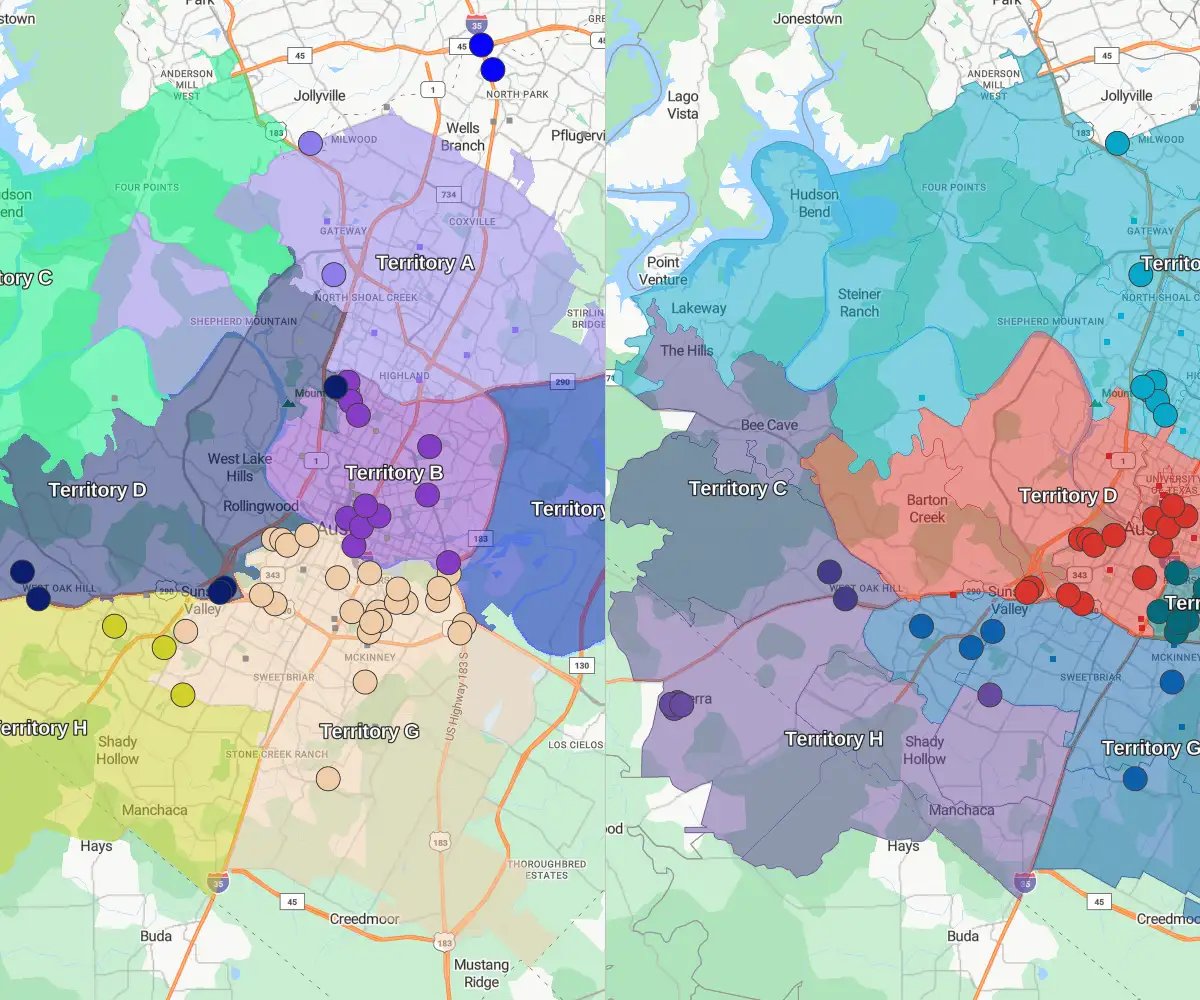Quick answer
Key Takeaways
- Assigning forecast managers, even placeholders, is essential to avoid broken forecasts and gaps in your pipeline reporting
- Role-based hierarchy and granular locking aren't just admin features; they're essential for maintaining clarity, access control, and uninterrupted sales activity
- Relying only on built-in Salesforce tools often results in slower planning and less flexible modeling; integrated mapping tools significantly speed up the process and reveal hidden inefficiencies by visualizing overlap, territory gaps, and account misalignment
Salesforce Territory Management has the potential to transform how your sales teams operate, but only when it's executed with precision. Without a structured approach, even advanced features can fall short. This guide explores proven best practices, common pitfalls, and the impact of integrating mapping software like eSpatial to help you design smarter territories, align teams, and accelerate performance.
What is Salesforce Territory Management?
Salesforce Enterprise Territory Management is a built-in CRM feature that allows organizations to assign accounts and opportunities to reps based on customized territory logic. By defining clear regional or strategic boundaries, companies can align reps to high-value areas and streamline operations. To get the most from this tool, many businesses now rely on mapping software for Salesforce data to visualize and manage these territories more effectively.
When to Use Territories in Salesforce
If you're currently using basic Salesforce Maps features, you may want to explore a more powerful Salesforce Maps alternative that provides more flexibility for territory modeling and performance tracking. It's important to know when to use territories in Salesforce to maintain optimal performance from your CRM. Adhering to Salesforce territory management best practices means recognizing when to implement territories to improve operational clarity and sales performance. Here's what to look for:
-
You have complex regional or strategic sales structures
-
Forecasting by
territory is required -
You need role-based visibility for multi-level sales teams
-
Reps are unintentionally
overlapping efforts
Best Practices for Salesforce
Territory Management
Like Salesforce Maps, Salesforce Territory Management can be a powerful tool for sales professionals; that is, if you know how to use it. You’re likely already familiar with how challenging the software is, so let’s get right into it.
Here are the top Salesforce territory management best practices, enhanced for modern, data-driven planning:
Step 1
Leverage Role Hierarchy in Territory Management
Not all team members need access to the same data. Establishing a clear role hierarchy is essential to maintaining security and organizational clarity. This structure helps you control who can view or edit specific information while also supporting reporting rollups, defining management relationships, and enabling other hierarchy-based workflows.
Step 2
Only Use Territories With Gorecast Managers
When forecasting in Salesforce, a territory will only be included in the final report if it has an assigned forecast manager. You must add a placeholder if there is no manager; otherwise, you'll receive incomplete data. It's always a good idea to double-check that each territory has a designated forecast manager with access to the necessary data.
Step 3
Accurately Define Your Named Accounts
Named accounts should be scoped using rule-based criteria. When these definitions are paired with geographic or strategic overlays, as outlined in the tips for visualizing Salesforce data, accuracy and consistency improve.
Step 4
Improve Performance With Granular Locking
Use locking tools to protect key structural changes without blocking everyday sales processes. This fine-tuned control minimizes errors during updates. Specific tasks related to territory hierarchies require admin-level locks, temporarily limiting what other users can do in the system. Granular locking helps minimize disruption by locking only the specific parts of the data table involved in the task.
Step 5
Consider Using an Integrated Territory Solution
While Salesforce Territory Management can be an excellent tool for some organizations, it's also notoriously difficult to use. A comprehensive territory software integration for Salesforce offers the best of both worlds. You can access your Salesforce CRM data seamlessly with easy-to-use, advanced territory management tools. The benefits of Salesforce mapping integration include clearer territory boundaries, better performance tracking, and faster optimization.
Common Salesforce Territory
Management Mistakes to Avoid
While implementing territory management in Salesforce, avoid the following common mistakes:
- Assigning reps without considering account density or market size
- Overlapping or redundant territories that confuse ownership
- Not assigning forecast managers to each territory
- Failing to update named account rules regularly
- Underutilizing visualization and spatial data to guide decisions
A strategic, map-based approach reduces these risks and supports smarter decisions. For example, enhance your Salesforce territory planning workflow to enable more precise modeling, faster edits, and stronger reporting.
The Benefits of a Salesforce
Territory Management Integration
A full-featured territory management integration, especially one with built-in mapping, allows your team to work faster and more accurately. These features enable organizations to move beyond static CRM workflows. For teams seeking better planning agility, this is the future of territory planning in Salesforce. Explore eSpatial pricing options to see what's possible for your business.
Benefits include
- Map-based editing that shortens planning cycles
- Better account-to-territory alignment using sales and demographic data
- Dynamic forecasting visuals tied to regional goals
- Simplified collaboration between leadership and reps
- Easier onboarding and change management through visual territory maps
How to Optimize Territory
Management With eSpatial
Optimizing sales territories is easy with eSpatial. Simply upload your Salesforce data or spreadsheets, and advanced algorithms automatically generate a vibrant map with geographic information and rich insights. You can draw your territory boundaries from there based on region, ZIP codes, or points. Add visual context with demographic overlays and advanced styling options. As your plans turn to action, eSpatial allows you to monitor sales performance across territories to see what's working and identify areas for improvement.
To help you design better territories in eSpatial, here are a few tips to consider:

1. Prioritize High-value Accounts
Start by assessing the value of each account within your segments. Be sure to identify and prioritize important prospects and customers to target them when it comes time to design your territory.

2. Divide Sales Reps Based on Business Objectives
While you're dividing reps into territories, you'll want to preserve any existing customer relationships. For instance, if one sales rep has worked with a specific client for a while, keeping them in their territory is a good idea to avoid unnecessary disruption.

3. Experiment With Territory Design
A sales territory plan doesn't have to be set in stone. As trends and markets change, you'll need to adapt your strategy to match. Be prepared to regularly review your territory plan to realign or balance as needed.

4. Track Territory Performance Over Time
Tracking sales performance between regions is critical to making the right territory management decisions. With a full view of your territory and sales activity, you get deeper insights that can drive efficiency and productivity.

